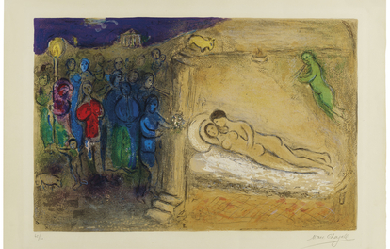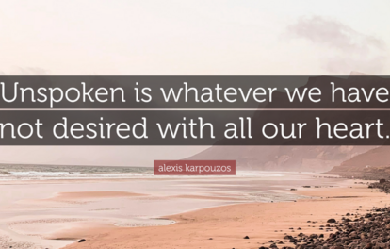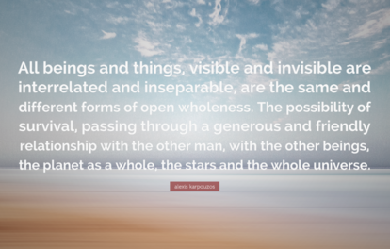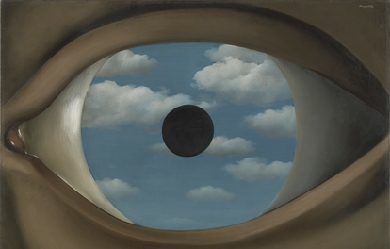
ONE AND THE MULTIPLE– ALEXIS KARPOUZOS
PHILOSOPHY OF MATHEMATICS
The relationship between the One and the Multiple in mystic philosophy is a profound and central theme that explores the nature of existence, the cosmos, and the divine. This theme is present in various mystical traditions, including those of the East and West, and it addresses the paradoxical coexistence of the unity and multiplicity of all things.
In mystic philosophy, the **One** often represents the ultimate reality, the source from which all things emanate and to which all things return. It is the absolute, the infinite, and the unchanging. The One is beyond all attributes and is often associated with the divine or the absolute truth.
The **Multiple**, on the other hand, represents the manifest world, the diversity of forms, and the realm of change and plurality. It is the world we experience through our senses, the domain of time and space, where differentiation and individuality are apparent.
The relationship between the One and the Multiple is not one of opposition but of emanation and unity. The Multiple is seen as a reflection, expression, or manifestation of the One. In this sense, the diversity of the world doesn’t contradict the unity of the One but rather demonstrates it in a myriad of forms.
Mystics seek to understand and experience this relationship through various practices and insights. They aim to transcend the illusion of separation and duality to experience the non-dual reality where the One and the Multiple are recognized as inseparable.
This concept can be illustrated by the metaphor of the ocean and its waves. The ocean represents the One—vast, deep, and all-encompassing—while the waves represent the Multiple—distinct, diverse, and ever-changing. Each wave is unique, yet it is not separate from the ocean. The wave’s existence is dependent on and made of the same substance as the ocean. In the same way, each individual entity in the Multiple is an expression of the One.
In summary, the relationship between the One and the Multiple in mystic philosophy is a dynamic interplay that challenges the conventional understanding of separation. It invites a deeper exploration of reality, where the apparent multiplicity of the world is a direct expression of the singular, underlying essence of all that is.
The relationship between the One and the Multiple in the context of mathematical philosophy is a profound topic that touches upon the very foundations of existence and knowledge. It’s a theme that has been explored by philosophers and mathematicians alike, often leading to the contemplation of unity and diversity within the structures of reality.
In mathematics, the concept of the One can be seen as the basis of unity from which all numbers derive. It’s the identity element in multiplication, the starting point in counting, and the foundation of dimension in geometry. The One is often associated with the concept of monism in philosophy, which posits that there is a single, underlying substance or principle that constitutes reality.
On the other hand, the Multiple represents the infinite variety and diversity of forms and numbers that arise from the One. It’s the embodiment of plurality and the complex interplay of different entities that mathematics seeks to understand and describe. This reflects the philosophical stance of pluralism, which acknowledges the existence of multiple realities or truths.
The interplay between the One and the Multiple can be seen in the mathematical concept of sets. A set can be thought of as a unity, a whole composed of distinct elements. Yet, each element within the set also retains its individuality, contributing to the diversity of the set’s composition. This duality is mirrored in the philosophical exploration of the universal and the particular, where the universal represents the One, and the particulars represent the Multiple.
In the realm of mathematical philosophy, this relationship often leads to questions about the nature of mathematical objects: Are they discovered as part of an objective reality (the One), or are they constructed by the human mind from a multitude of experiences (the Multiple)? This debate resonates with the philosophical inquiry into the nature of truth and reality.
Reflecting on the One and the Multiple can also lead to a deeper understanding of the self and the cosmos. Just as the number one is integral to the existence of all other numbers, the individual self can be seen as a unique expression of the universal whole. Similarly, the cosmos can be viewed as a grand unity composed of a multiplicity of forms and phenomena.
Gödel’s incompleteness theorems have a fascinating connection to the philosophical concepts of the One and the Multiple. These theorems, which are pivotal in mathematical logic and philosophy of mathematics, articulate the inherent limitations of formal axiomatic systems, particularly those sufficient to express the arithmetic of natural numbers.
Gödel’s incompleteness theorems have a fascinating connection to the philosophical concepts of the One and the Multiple. These theorems, which are pivotal in mathematical logic and philosophy of mathematics, articulate the inherent limitations of formal axiomatic systems, particularly those sufficient to express the arithmetic of natural numbers.
The **first incompleteness theorem** reveals that within any such consistent system, there are propositions that are true but cannot be proven within the system itself. This reflects the idea of the Multiple in that there is an abundance of mathematical truths, a multiplicity that exceeds the unifying framework of any one system. It suggests that the realm of mathematical truth is more extensive than any single formal system can fully capture.
The **second incompleteness theorem** extends this by showing that a system cannot prove its own consistency. This relates to the concept of the One, as it implies that a system’s complete self-understanding, its unity and coherence, is unattainable from within. It must look beyond itself, to an external vantage point, to ascertain its consistency.
In the context of the One and the Multiple, Gödel’s theorems imply that the One (a consistent formal system) is inherently incomplete and cannot encompass the Multiple (the totality of mathematical truths). This resonates with philosophical discussions about the relationship between unity and plurality. Just as a single philosophical system cannot capture the entirety of truth, a single formal mathematical system cannot encapsulate all mathematical truths.
Moreover, Gödel’s work suggests that the pursuit of a single, unified theory of everything in mathematics—a One that encompasses all Multiples—is an inherently Sisyphean task. There will always be more truths (Multiples) than can be derived from any given set of axioms (the One).
In essence, Gödel’s incompleteness theorems provide a formal underpinning to the philosophical notion that the One cannot exist without the Multiple, and vice versa. They are interdependent, with the One giving rise to the Multiple, and the Multiple necessitating the One for its expression and comprehension. This interplay is a dance of limitations and possibilities, where the boundaries of logic, mathematics, and philosophy blur into one another.
The relationship between the One and the Multiple in the context of the mathematics of zero is a deeply philosophical inquiry that bridges the abstract world of numbers with the existential questions of being and non-being.
Zero, in mathematics, is a symbol of absence, a representation of nothingness, yet it holds a pivotal position as a number. It is the void from which all things emerge and to which they return. In the philosophy of mathematics, zero is the paradoxical junction where the One and the Multiple converge and diverge.
From the perspective of the One, zero can be seen as the origin—the singular point that precedes the existence of numbers. It is the empty set, the foundation upon which the edifice of mathematics is constructed. As the identity element in addition, zero maintains the integrity of numbers, for adding zero to any number leaves it unchanged, reflecting the immutable nature of the One.
Conversely, when we consider the Multiple, zero represents the infinite potentiality of creation. It is the canvas upon which the integers, both positive and negative, express their multitude. Zero is the balance point, the fulcrum around which the symphony of numbers dances. It embodies the plurality of possibilities, the beginning of the number line that stretches infinitely in both directions.
Philosophically, zero challenges our understanding of existence. It is both something and nothing—a number that quantifies the absence of quantity. This duality echoes the philosophical struggle to comprehend how the One gives rise to the Multiple. How does the unity of being manifest the diversity of the cosmos? Zero offers a mathematical metaphor for this mystery, as it encapsulates the transition from non-existence to existence, from the undifferentiated One to the differentiated Multiple.
In the realm of set theory, zero corresponds to the empty set—a set with no elements. This set is unique in that it is the only set that contains nothing, yet it is the foundation upon which all other sets are built. The empty set is the mathematical embodiment of the One, and all other sets, containing multiple elements, arise from it.
Reflecting on zero in the context of Gödel’s incompleteness theorems, we find a resonance with the idea that the One (a consistent formal system) cannot capture the entirety of the Multiple (the totality of mathematical truths). Zero, as the foundation of numbers, similarly suggests that from the nothingness of the One, the infinite complexity of the Multiple emerges—yet it can never be fully encompassed or expressed by any single system.
In conclusion, the mathematics of zero offers a profound reflection on the relationship between the One and the Multiple. It serves as a bridge between the abstract and the concrete, the known and the unknowable, challenging us to ponder the origins of existence and the nature of reality itself.

















